Sapphire Nitro+ RX 470 OC Graphics Card Review
John Williamson / 8 years ago
Introduction
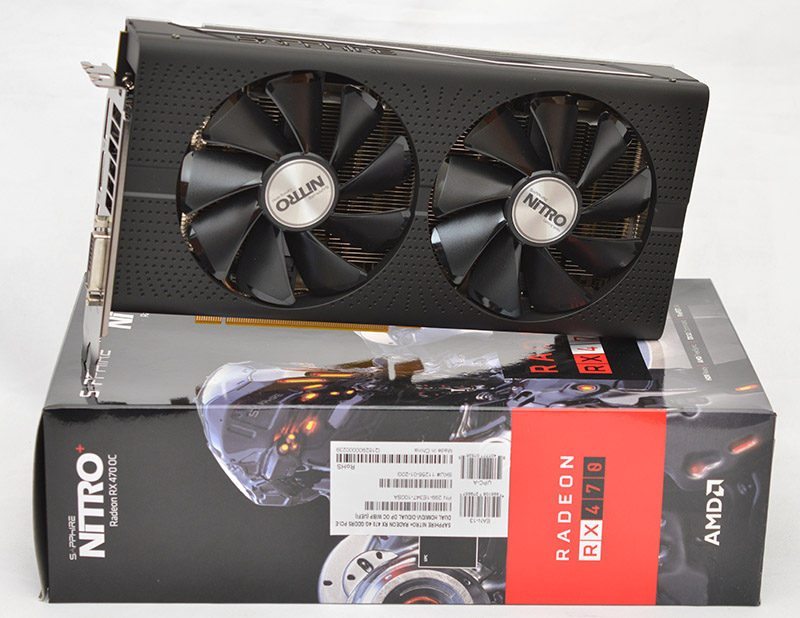
Not so long ago, Sapphire unveiled the Nitro+ RX 480 OC graphics card which allowed AMD’s flagship Polaris 10 core to perform to its maximum potential. This is due to the company’s exceptional cooling solution which managed to tame the GPU’s thermal loads and in turn, ensured the boost clock didn’t plummet in a wide range of demanding games. Unfortunately, AMD’s relatively simplistic reference cooling design doesn’t contain any heat-pipes and relies on a single aluminium heatsink with a copper base. This was inadequate for overclocking and after speaking to AMD, they acknowledged it could have been engineered better. While the RX 480 offers outstanding value for money and targets the mainstream demographic, the price point might still be too high for certain consumers on a tight budget or those considering PC gaming for the first time. Thankfully, the RX 470 can dispel those concerns and is a slightly scaled back version of the RX 480. This particular configuration is capable of up to 4.9 TFLOP/s peak performance, has 32 compute units, 2048 stream processors all within a very respectable 150-watt TDP on models sporting an 8-pin connector.
As you might expect, the Sapphire Nitro+ RX 470 OC utilises the same cooling apparatus as its bigger brother and contains a BIOS switch to cycle between two modes. The silent mode features a 1206MHz boost clock and the memory runs at 1750MHz. If you require extra performance, then the Boost mode is a suitable choice given the higher 1260MHz clock speed. Evidently, this is a significant step up from Sapphire’s other RX 470 which is based on the reference model. Therefore, I expect to see some pretty significant frame-rate improvements as from my own experience, the boost clock is very stable and doesn’t fluctuate. Is the Nitro+ RX 470 OC worth the premium compared to more basic solutions? Let’s find out!
Specifications

Packing and Accessories
Sapphire’s vertical RX 470 box leaves a striking impression due to the menacing robot cover which stands out beautifully on the black background. Also, the packaging informs the end-user about the GPU’s DirectX 12 support, VRAM size and a number of innovative AMD technologies.
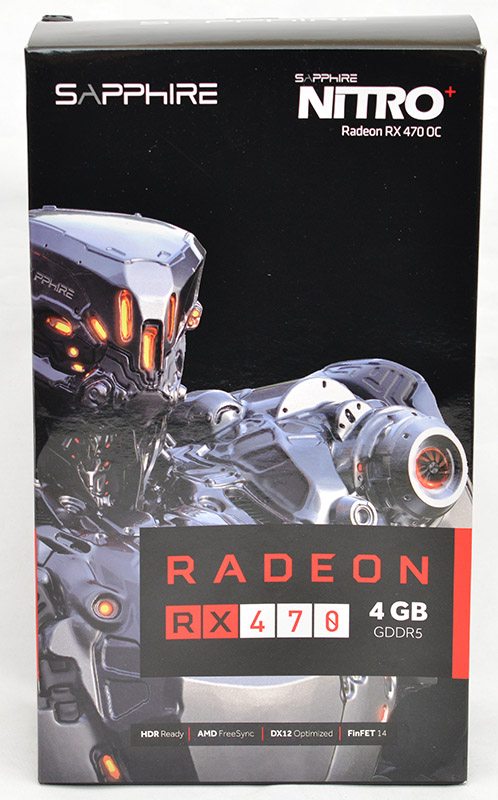
The packaging contains a description of the product’s 14nm FinFET manufacturing process alongside a whole host of other interesting information. Additionally, a feature list provides a great insight into the graphics card’s wonderful functionality. Rather surprisingly, the Crossfire support appears to be restricted to two GPUs and this is something I’d like to test for myself rather soon.
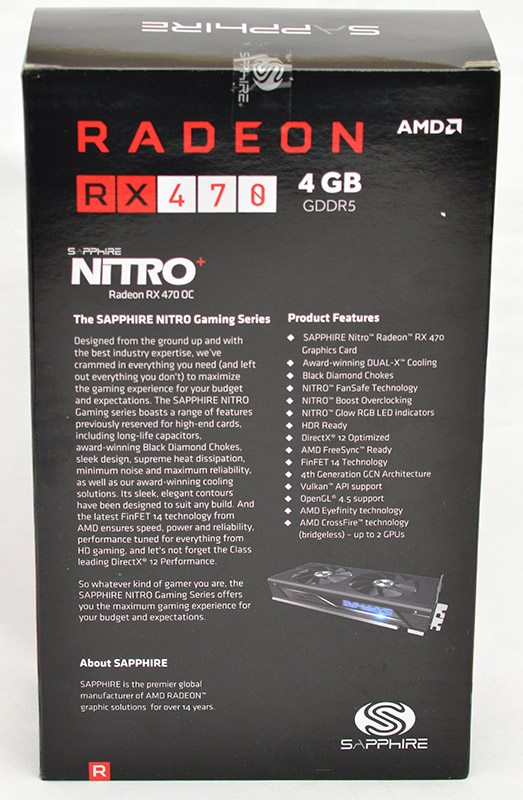
The graphics card comes with a driver disk, quick installation guide, contact information and warranty registration leaflet.
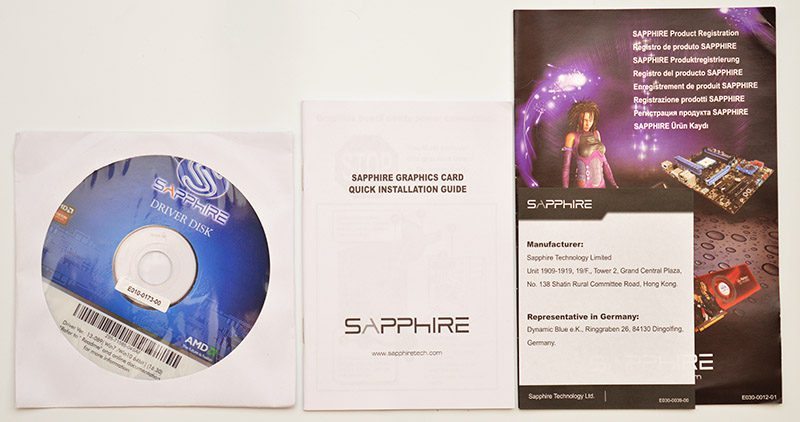
A Closer Look
From a visual standpoint, Sapphire’s latest cooling hardware is sublime and revolves around an elegant design strategy. Instead of trying to merge far too many colours together in an unattractive fashion, Sapphire decided to keep things simple and uphold the notion that less is more. This neutral colour scheme isn’t overbearing and should compliment a wide range of gaming systems sporting contrasting colour schemes.
I’m particularly fond of the small indentations scattered across the matte gunmetal shroud. This finish resists finger marks and dust built-up rather well and captures people’s attention. It’s probably the best looking graphics card I’ve seen for a long time and evokes a premium feel.
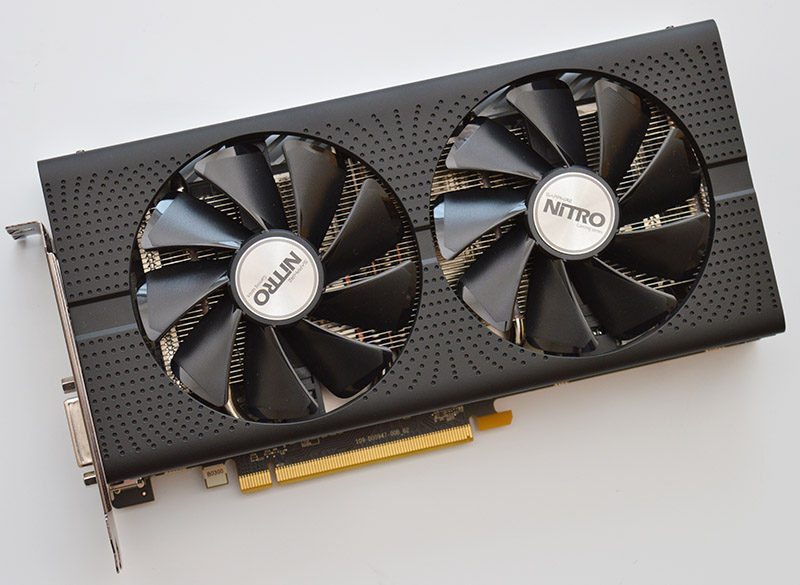
On a more technical note, the Sapphire Nitro+ RX 470 OC has a custom PCB, dense fin array aluminium heatsink and nickel plated copper heat-pipes. Also, high-quality Black Diamond Chokes 4 have been utilised which reduce coil temperatures by 15% compared to the previous version. Evidently, Sapphire haven’t made any cutbacks and bundled the best possible selection of components.
While the front section looks absolutely breathtaking, the backplate is the real showpiece. In my opinion, this is the best-looking backplate ever created and I particularly love the gorgeous colour coordination and sleek lines. Even the Nitro branding adds to the backplate’s aesthetic appeal and everything is beautifully balanced.
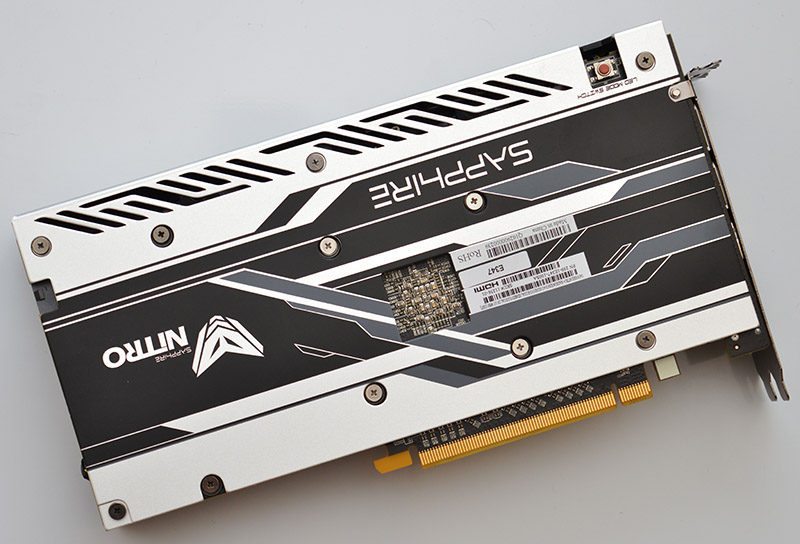
The latest version of Sapphire’s cooling fans offers 85% longer lifespan than the previous generation. Even more impressive, these 95mm dual bearing fans are 10% quieter and can easily be replaced just in case any technical problems arise. Replacing the fans is a rudimentary process and involves unscrewing a single screw which holds them firmly in position. Sapphire selected this method to prevent users from accidentally removing the fans when handling the graphics card. It’s also possible that some users might find it too satisfying when using a clicking mechanism and remove the fans on a regular basis without a logical reason.
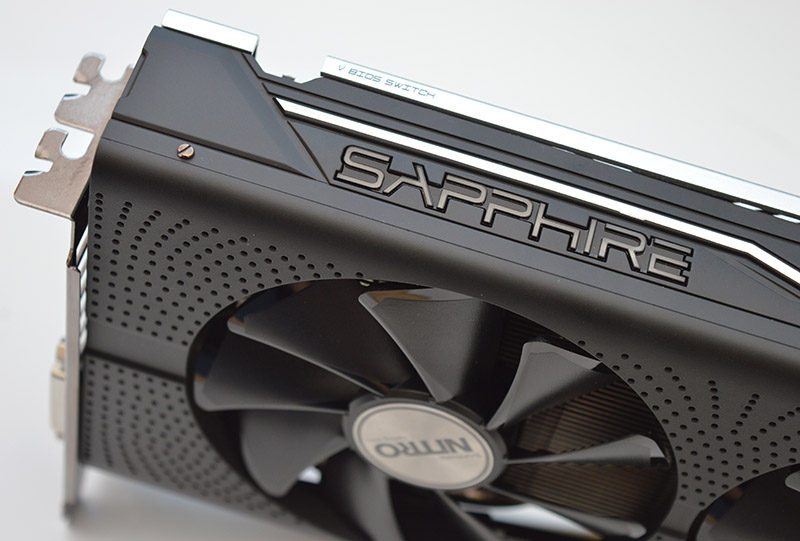
The ability to remove the fans improves RMA times and simplifies the process. Now, consumers can request replacement fans and not have to send the GPU to a repair centre at their cost. This makes sense because the fans are the most likely element to fail over time. Not only that, an upcoming update to Sapphire’s overclocking utility will also allow the end-user to receive help and perform fan diagnostics. Removing the fans is handy to eliminate dust build-up which has the potential to impact on fan efficiency. Thankfully, Sapphire’s fan removal system is brilliant and provides the end-user with greater flexibility.
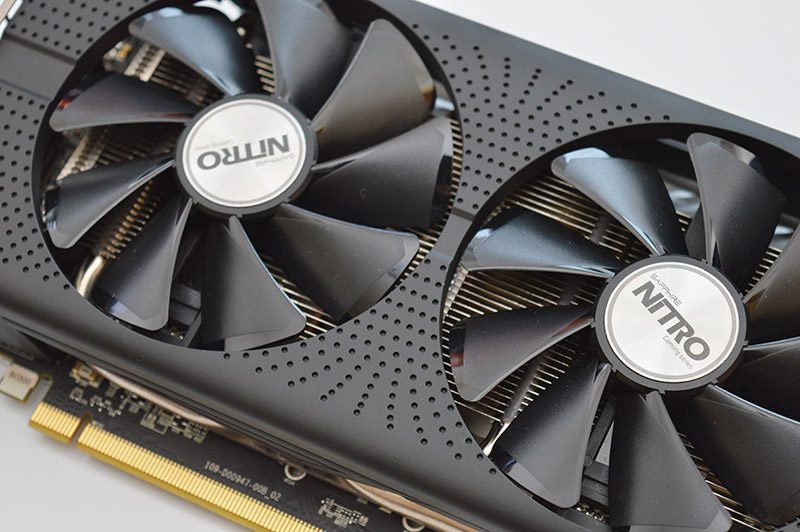
Unlike the Sapphire reference model, an 8-pin PCI-E connector has been used to enhance the overclocking headroom and ensure the GPU has enough power in extreme usage scenarios. Also, notice the side positioning similar to the R9 Nano which is fairly unusual but another excellent addition. From this image, we can see the thick custom PCB and aluminium heatsink.
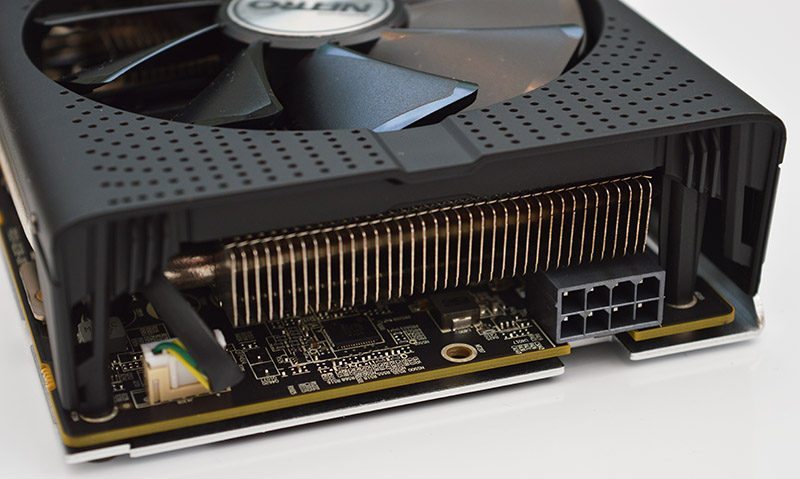
In a similar vein to the Sapphire Nitro+ RX 480 OC, the graphics card has a BIOS switch featuring two modes. The silent profile is designed for those who value noise at the expense of performance while the higher-end BIOS features an impressive 1260MHz clock. In contrast to many of their competitors, Sapphire focused on a manual BIOS switch instead of a software implementation. I prefer this because it’s not a resource hog and adds less bloatware to your gaming PC.
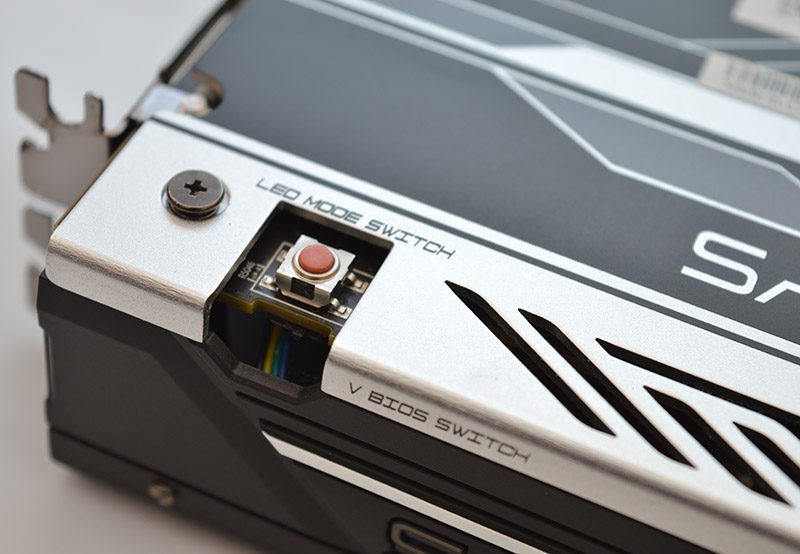
The company’s new Nitro Glow technology incorporates a wide range of RGB lighting options including static, rainbow shift, change colour by fan speed, and PCB temperature. Of course, RGB lighting isn’t to everyone’s tastes and it’s possible to disable the illumination using an onboard switch. By default, the graphics card employs a static blue colour which fits in with Sapphire’s theme. The lighting revolves around Sapphire’s name and isn’t too ostentatious. Please note, an upcoming revision to Sapphire’s TriXX 3.0 software will include lighting customization upon release.
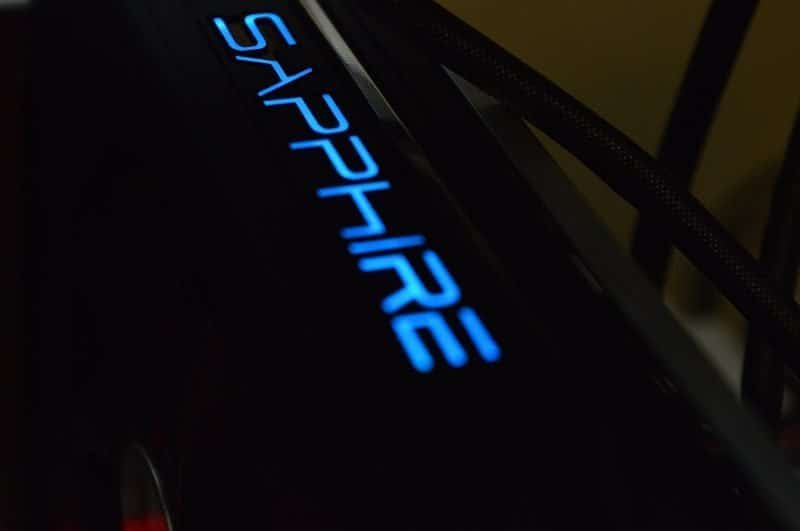
The rear I/O contains two DisplayPort 1.4, a dual-link DVI-D and two HDMI 2.0b. AMD’s latest architecture supports HDR and 4K h.265 encode/decode. As you can see from the photo below, Sapphire included optimised air vents in the I/O section to maximise airflow and in turn, reduce temperatures.
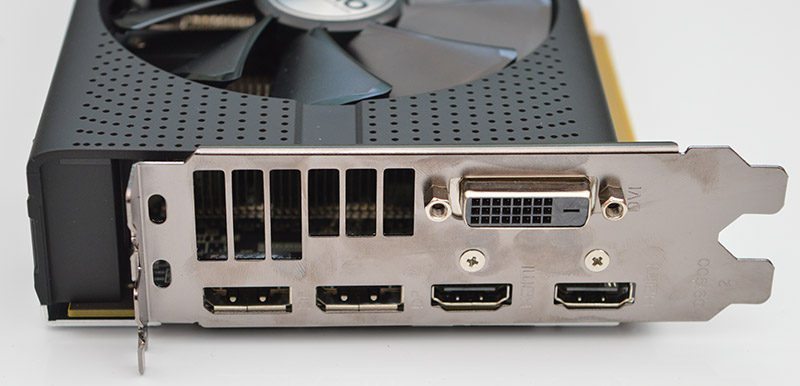
Testing & Methodology
Here is the test system we used for all graphics card reviews and game performance analysis:
Hardware
- Motherboard – Gigabyte X99-Gaming G1 WiFi LGA 2011-3 Motherboard
- Processor – Intel Core i7 5820K at Stock 3.3GHz
- RAM – 16GB (4 X 4GB) Crucial Ballistix Sport DDR4 2400MHz
- CPU Cooler – Thermaltake Water 3.0 with Gelid GC-Extreme
- Power Supply – BeQuiet Dark Power Pro 11 1200W
- Main Storage Drive – Crucial M550 512GB
- Chassis – Lian Li T80 Test Bench
- Displays – AOC U2868PQU 4K
- Operating System – Windows 10 Pro 64-Bit
Additional Hardware
- “Killawatt” style electricity usage meter wall plug
- Precision Gold N05CC Decibel meter
Drivers
The latest drivers are always used at the time of testing, but please note reviews undergo a scheduling process. This means a new driver could be released on the day of publication. However, this is unavoidable and disclosing the driver versions used is the most transparent way of informing the reader about current performance levels.
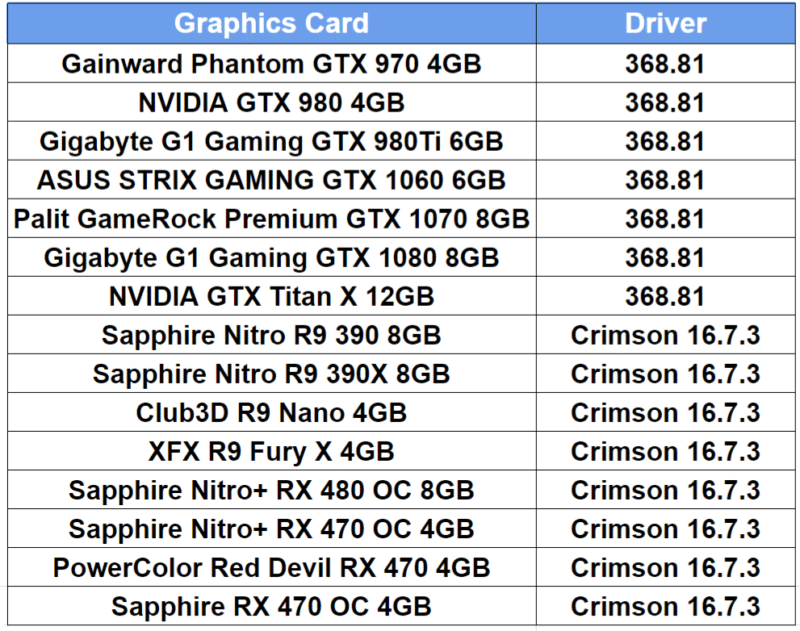
Games
Throughout the testing procedure, we always use demanding presets to stress graphics cards to their absolute limits. However, in the interest of fairness, any technology which favours either AMD or NVIDIA is disabled. More specifically, this refers to PhysX, Hairworks and more. Additionally, we also disable all forms of AA to gauge performance levels which aren’t impacted by complex AA. Theoretically, we could have employed FXAA because it only has a minor impact on the frame-rate, but many users strongly dislike the hazy image this causes. Apart from the details mentioned above, all settings remain at the maximum values. On another note, we previously used Grand Theft Auto V in the testing process and it’s a popular title. However, there’s been some strange anomalies in the minimum frame-rate which mean I’m not confident in the benchmark’s accuracy.
Since I’ve taken the helm as graphics card reviewer, I wanted to put fairness at the heart of each article and ensure there’s a good balance between DirectX 11 and DirectX 12 games. This allows us to properly analyse each graphics card as focussing on sponsored titles from a particular vendor will always result in an inaccurate picture. Unfortunately, popular monitoring software like FRAPS cannot display the frame-rate in real time and poses a problem when observing performance numbers. Thankfully, it’s still possible to use FRAPS’s Min/Avg/Max function which we’ve found offers the most reliable monitoring compared to other methods. If you have any suggestions to aid the benchmarking process, please let us know so we can constantly improve the procedure.
Selecting strenuous presets especially at higher resolutions can cause hitching and other performance problems on graphics cards with lower amounts of video memory. For example, Rise of the Tomb Raider’s Very High textures really requires 6GB of RAM to maintain a smooth frame-rate. In theory, we could run the benchmarks at the High setting but this defeats the purpose of high-end graphics cards which are designed to cope with the absolute best graphics on the market. Furthermore, the notion of enthusiast cards sporting less than 6GB memory will become less of an issue in the future. Of course, whenever we’re tackling more affordable GPUs, the settings will be altered accordingly.
To reiterate, all settings are set to their maximum values apart from AA and vendor exclusive technologies. Sometimes, selecting the maximum preset doesn’t combine all the best settings, so we double check these and manually confirm the highest graphical preset has been enabled. The only one important aspect to mention revolves around Exclusive FullScreen in Rise of the Tomb Raider. Judging by the thorough testing, the frame-rate is much better when using this particular mode.
Software
- Ashes of the Singularity (DirectX 12)
- Doom (Vulkan)
- Far Cry Primal (DirectX 11)
- Just Cause 3 (DirectX 11)
- Hitman (DirectX 12)
- Rise of the Tomb Raider (DirectX 12)
- 3DMark
- Unigine Valley
- Unigine Heaven
- CPU-ID HWMonitor
- TechPowerUp GPU-Z
- Luxmark
Synthetic Benchmarks
During our testing, we use a range of readily available synthetic benchmarking tools which are free to download from the respective websites. We do this so the readers can download and compared to our results. Download links are contained within the “Software” subheading.
Noise
Everyone has their own reasonable noise level when it comes to comes to components in a computer. Some can handle all fans at 100% load to keep temperatures down, some want a completely silent computer. To properly gauge the noise output of a graphics card, we position a Precision Gold N05CC Decibel meter from two metres away and take an average reading.
Power Consumption
With electricity becoming increasingly expensive across most parts of the world the need for computer components to become power efficient has never been more relevant. Graphics cards are often the most power-hungry components of a desktop system so having an efficient graphics card is very important to keeping power bills under control. Power is often correlated to heat and so lower power consumption means a graphics card is likely to run slightly cooler and put out less heat into your system meaning your other components will run cooler with improved longevity. AMD and NVIDIA have both made power consumption an integral part of the way graphics cards dynamically overclock so the need for graphics card vendors to use efficient VRM and PCB designs is becoming important to maximise performance. We take power readings after 5 minutes of two different load scenarios: desktop idle and Unigine Heaven load.
Temperatures
The cooling solution which graphics card vendors choose to implement is one of the main differences that consumers have to contend with when choosing a graphics cards. Apart from their acoustic properties, the thermal properties of graphics card coolers are extremely important. Lower temperatures are always better and with AMD and NVIDIA opting to use dynamic overclocking algorithms that take temperature into account it is important that graphics card vendors use high-performance cooling solutions in order to maximise performance. The era of graphics cards reaching dangerous temperatures are now in the past but the importance of lower temperatures still remains. Lower temperatures mean better stability, longer component longevity and lower fan speeds .We take temperature readings after 5 minutes of two different load scenarios: desktop idle and Unigine Heaven load. We always record actual temperatures and make any adjustments for changes in the thermal testing environment.
3D Mark
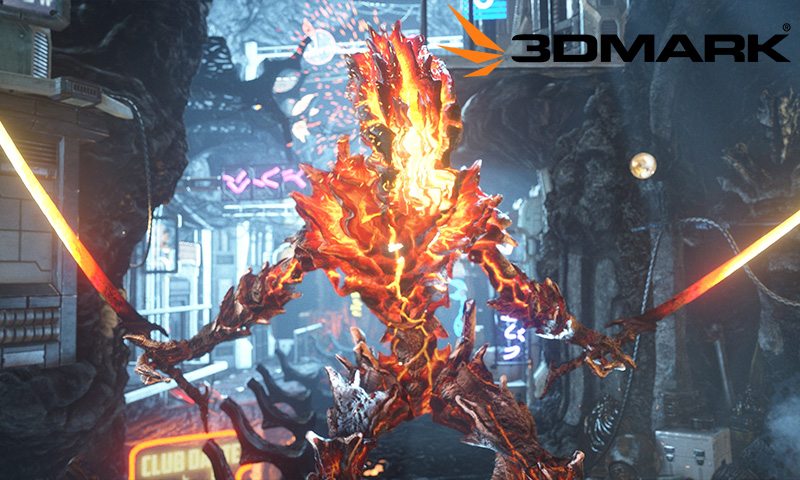
In 3DMark Fire Strike, the graphics card offers very similar performance to its nearest rival and destroys the Sapphire reference edition.
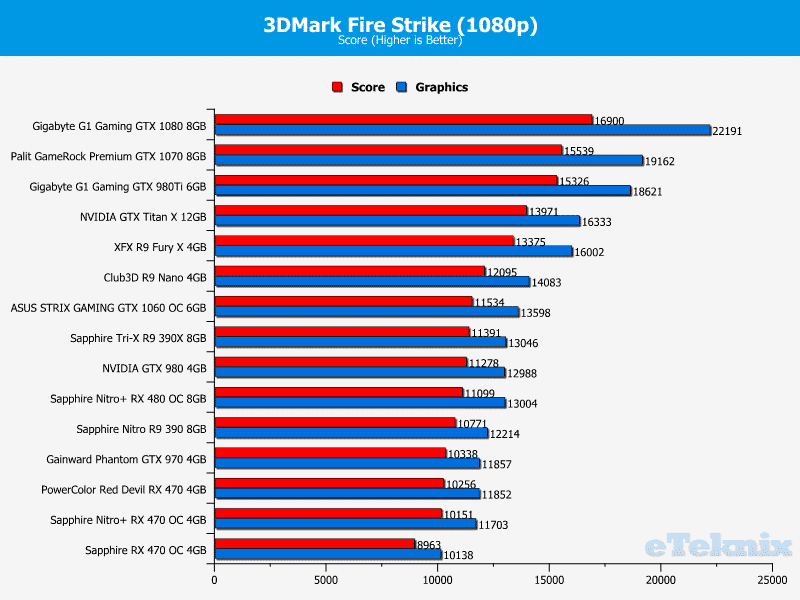
Once the resolution is increased to 1440p, the GPU fares pretty well even though it’s behind another custom RX 470.
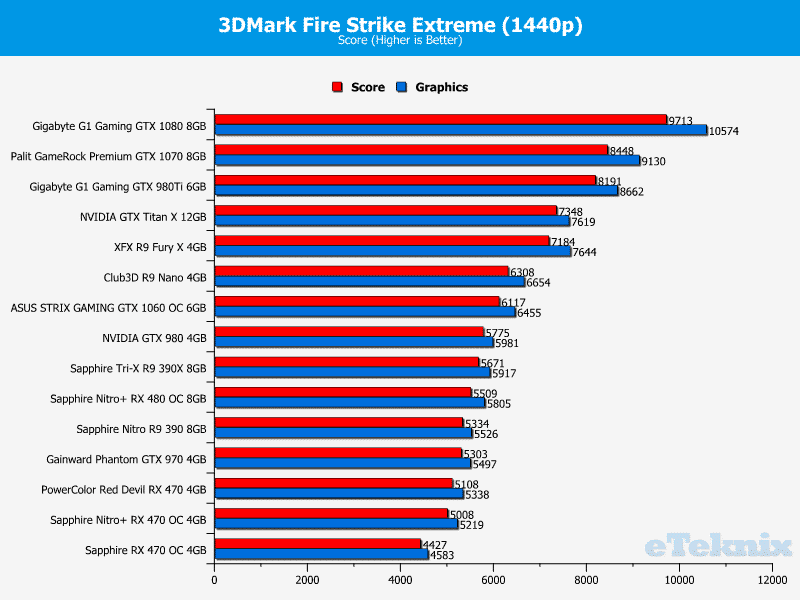
During 4K benchmarking, the Sapphire Nitro+ RX 470 OC outperforms the aforementioned PowerColor model and obtains a graphics score close to the GTX 970.
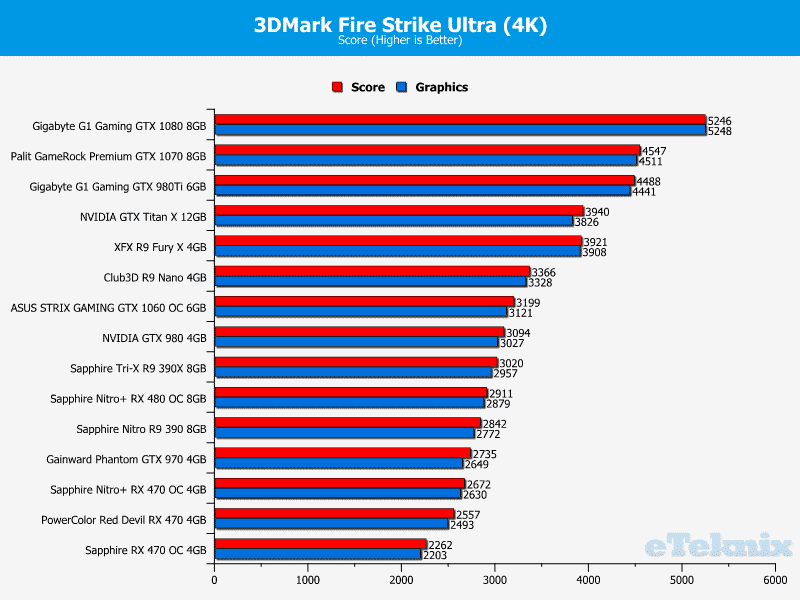
Compute Performance
When it comes to compute performance, there’s very little to choose between numerous RX 470 cards. Interestingly, there’s quite a large difference to the RX 480 which suggests it’s better suited to OpenCL tasks.
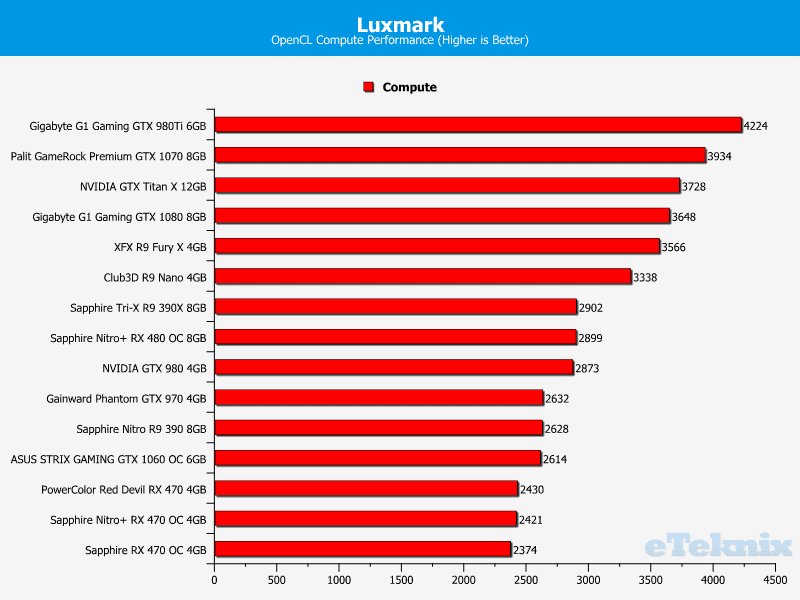
Ashes of the Singularity
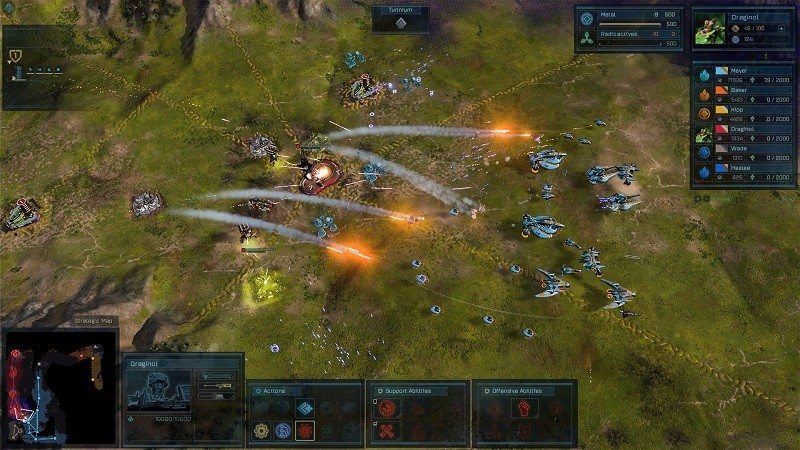
Here we can see the Sapphire Nitro+ RX 470 OC upholds a better average frame-rate than the GTX 980 and is within touching distance of another premium RX 470 product. Also, the deficit to the RX 480 remains relatively small.
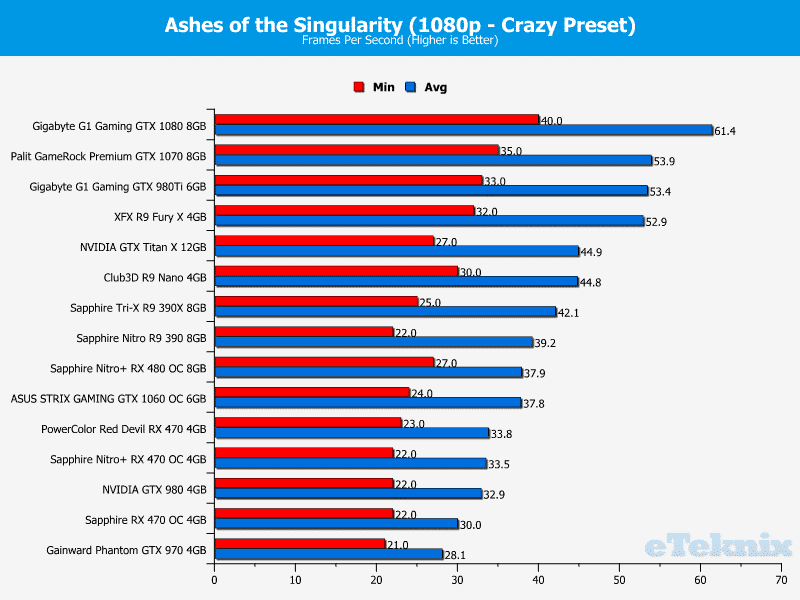
A similar pattern emerges throughout 1440p testing and the graphics card maintains its strong showing compared to other products in the same performance tier.
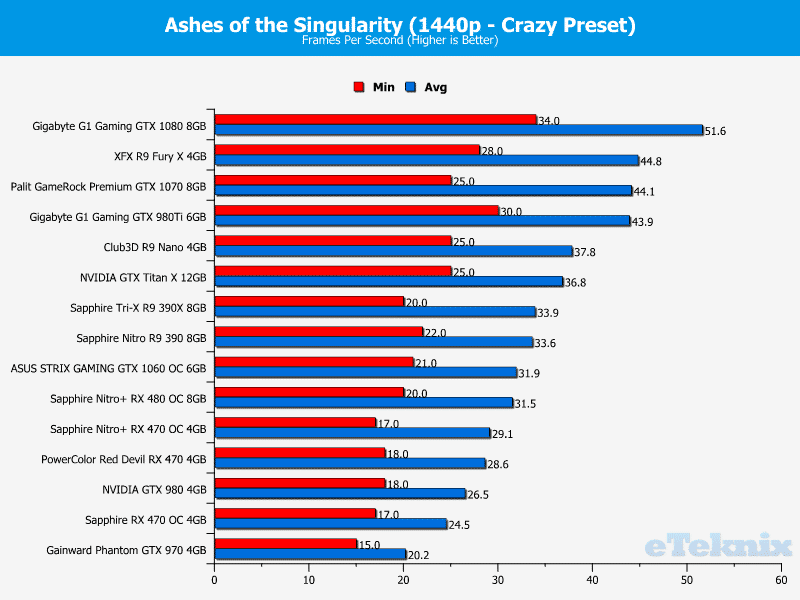
As expected, the GPU struggles to cope with the demanding preset on a 4K monitor but it’s still able to push ahead of the GTX 980.
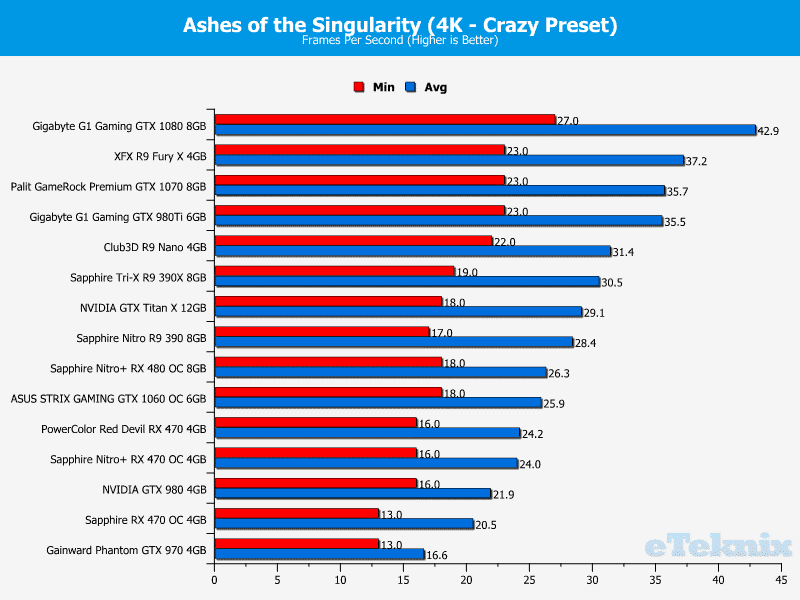
Doom
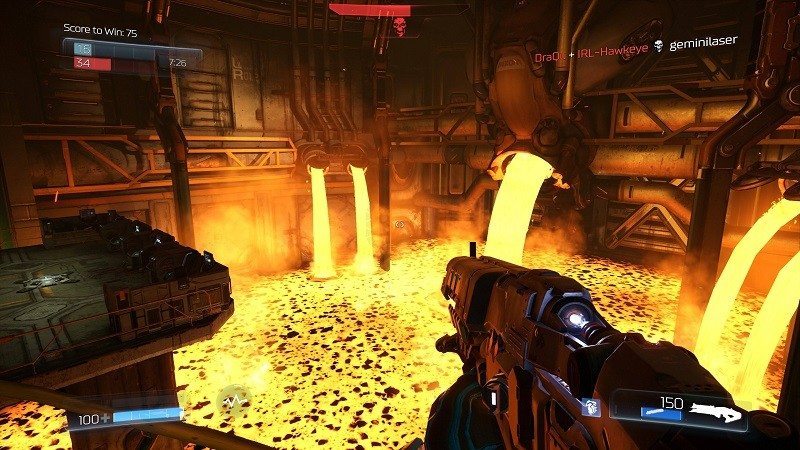
The Vulkan API greatly benefits AMD graphics cards and this is certainly the case for the RX 470. When playing the game on a 1080p display, the frame-rate is extremely high and doesn’t have any substantial dips. Saying that, the GPU trails the Sapphire Nitro+ RX 480 OC by a surprisingly large amount.
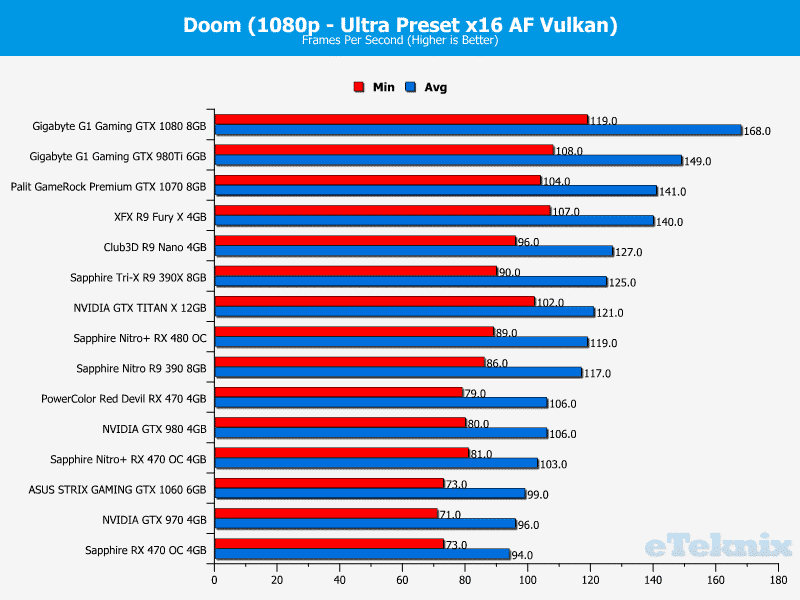
After increasing the resolution to 2560×1440, the graphics card upholds a perfectly respectable frame-rate and has enough performance to please the average end-user.
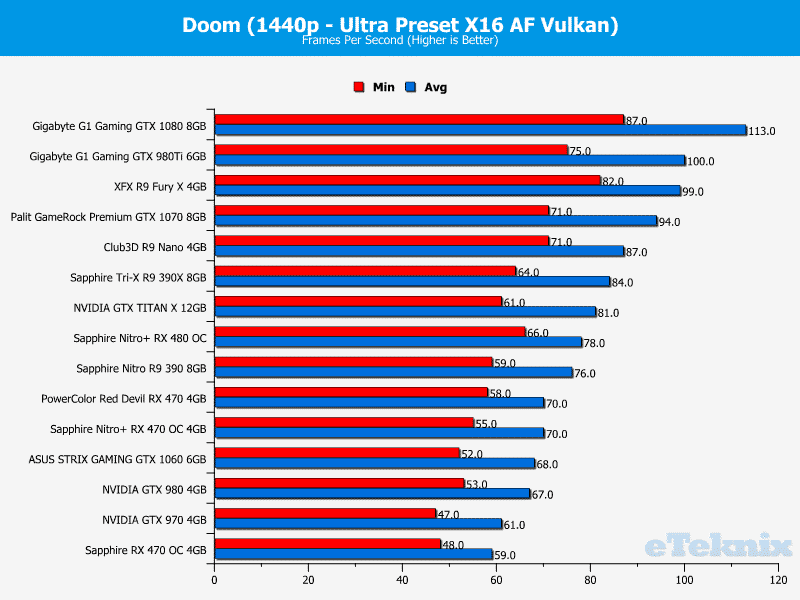
Even when paired with a 4K monitor, the frame-rate doesn’t plummet and you should be able to achieve 60 with reduced settings. Also, the graphics card maintains its slim lead over the ASUS STRIX GAMING GTX 1060.
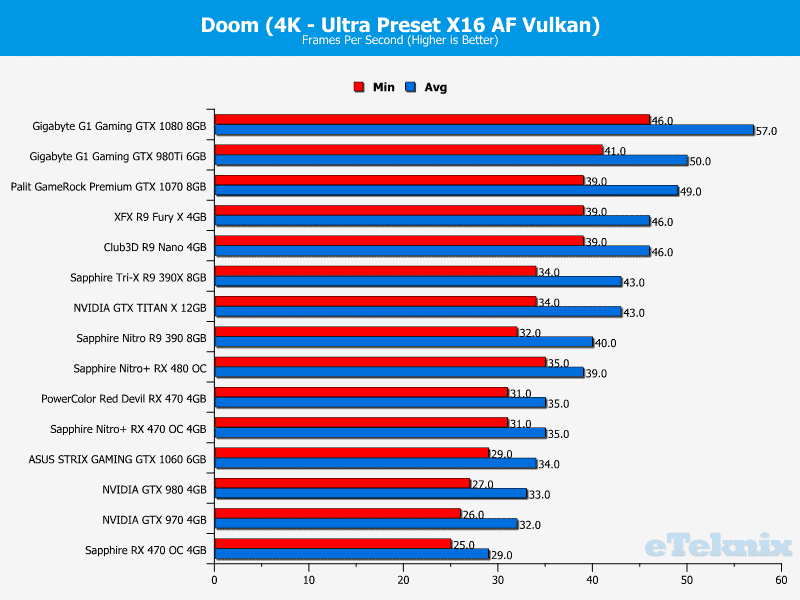
Far Cry Primal

In Far Cry Primal, the graphics card offers the same performance as its nearest competitor and maintains an average frame-rate just under 60.
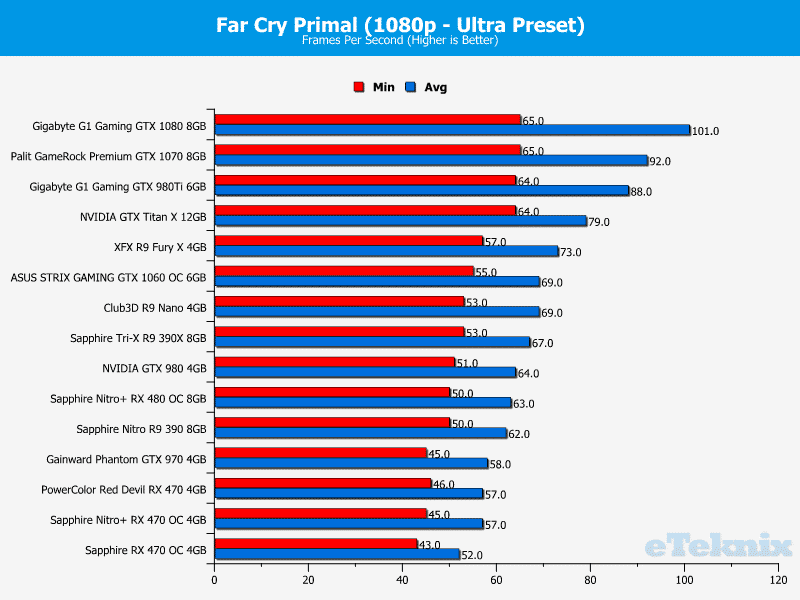
Once the resolution is set to 1440p, the graphics card records a 5 frames-per-second gap the RX 480.
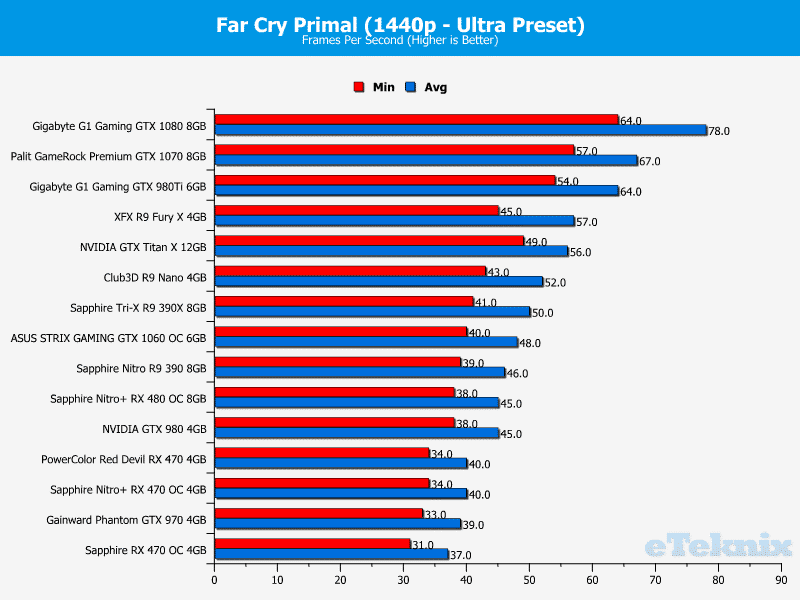
During 4K testing, the Sapphire Nitro+ RX 470 OC struggled to complete the benchmark and posted an unplayable average frame-rate. Of course, this isn’t a surprise since the GPU is primarily designed for 1080p gaming.
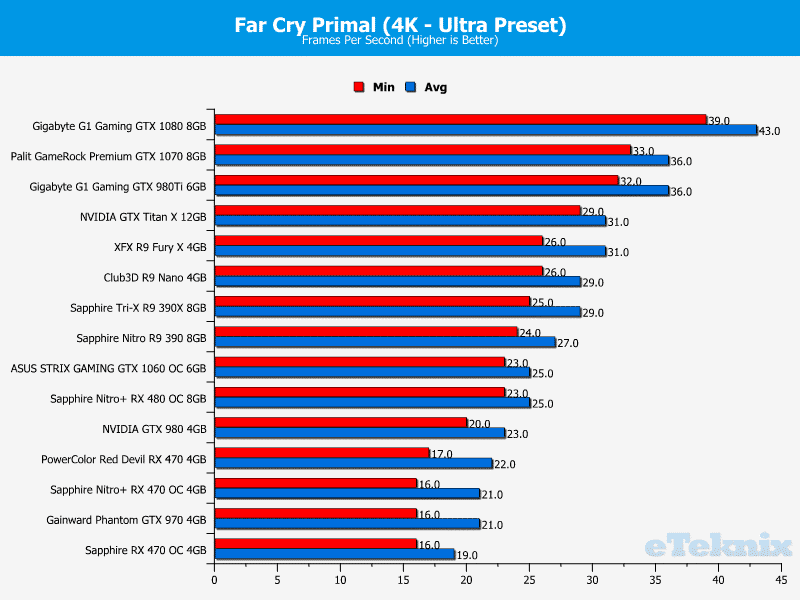
Hitman
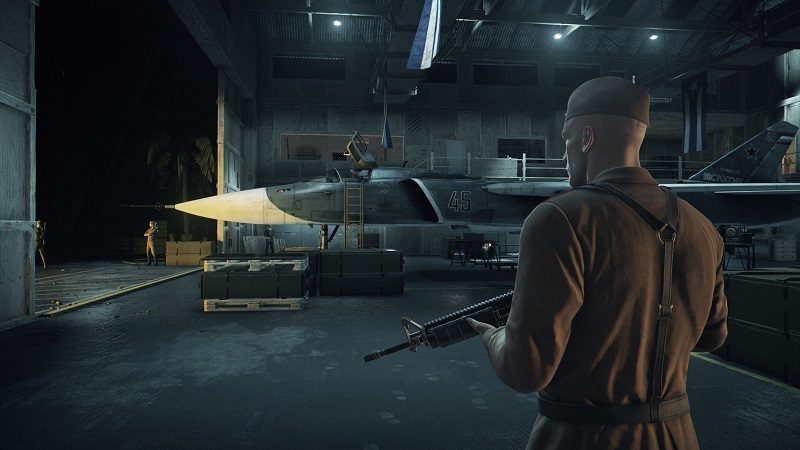
When tackling the Hitman benchmark, the Sapphire Nitro+ RX 470 performs brilliantly although it’s a relatively large margin behind the RX 480.
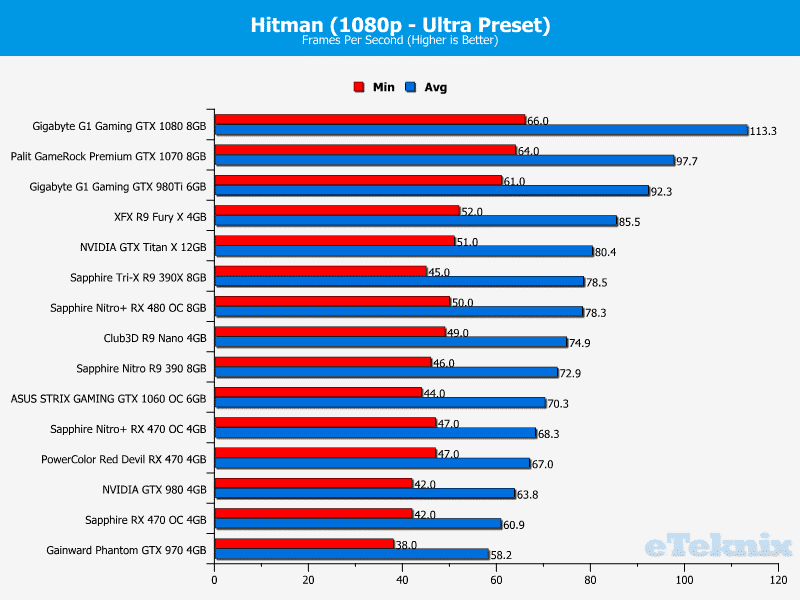
Throughout 1440p testing, the graphics card manages a stable frame-rate and provides a great boost compared to Sapphire RX 470 OC.
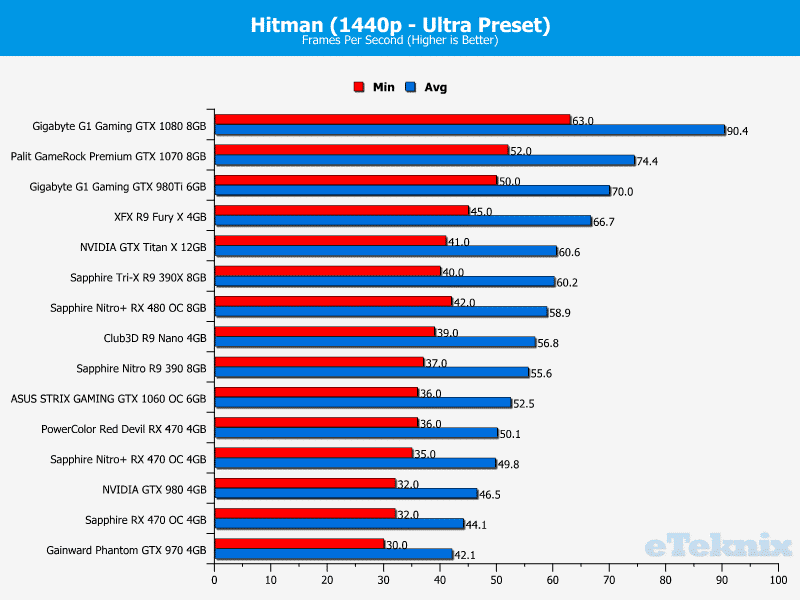
As expected, the performance on a 4K monitor isn’t great just like the majority of cards on the test bench.
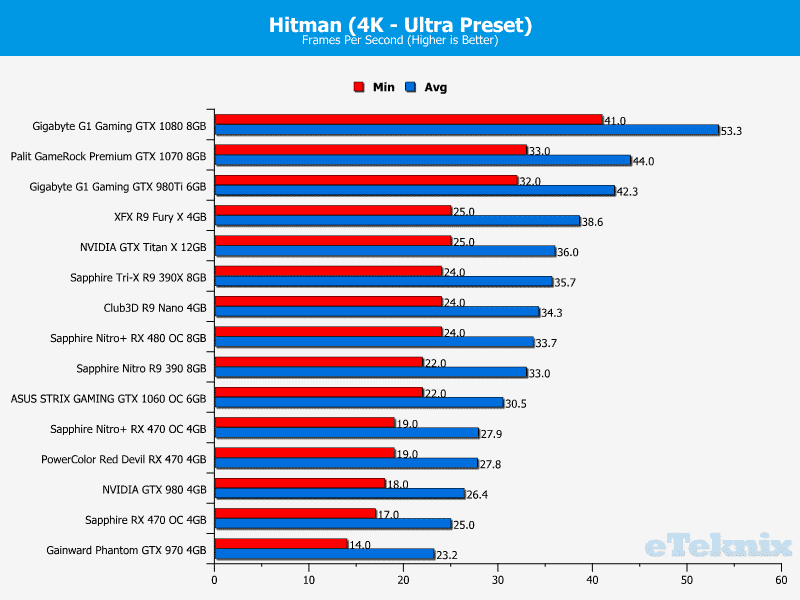
Just Cause 3

Here we can see the GPU attains a very high frame-rate and manages to outperform the R9 390X. This is a fantastic showing which greatly exceeded my expectations.
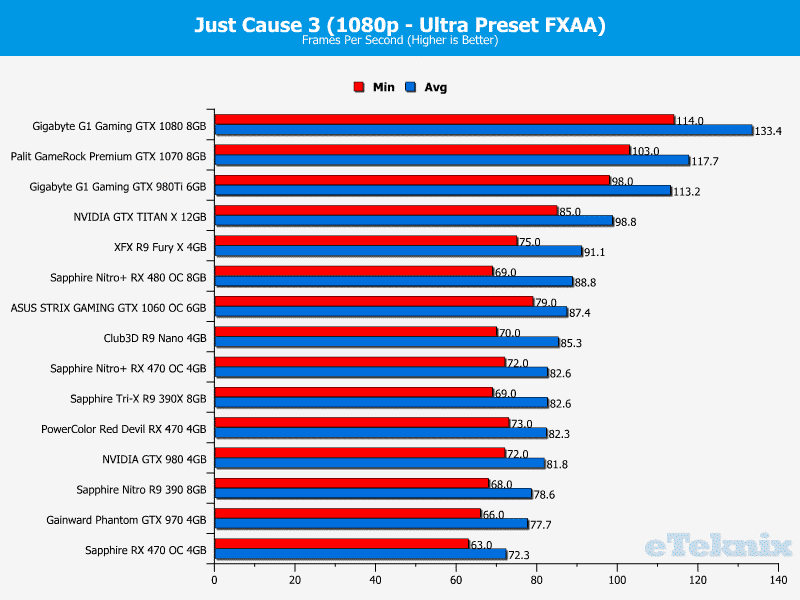
After the resolution was increased to 1440p, the performance remains solid and you shouldn’t encounter any major hitching or frame dips.
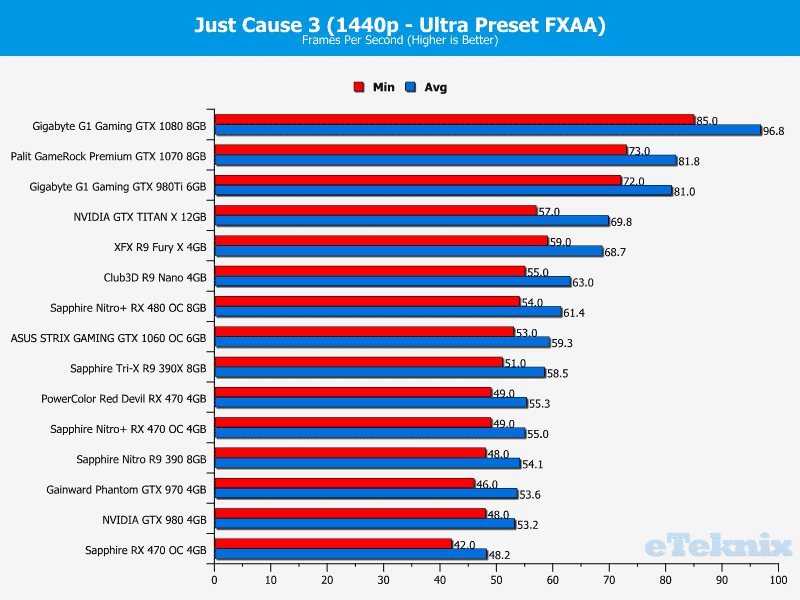
Unfortunately, running the game on a 4K monitor with an advanced graphical preset just isn’t possible.
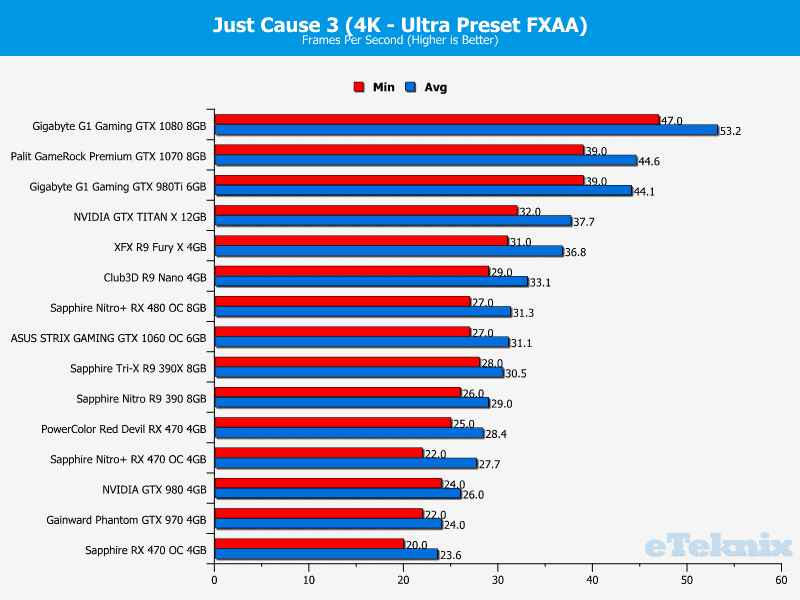
Rise of the Tomb Raider

In Rise of the Tomb Raider, the graphics card excels and almost matches its bigger brother. I was surprised by the tiny deficit especially since the gap was relatively large during the Hitman benchmark.

Despite the hefty demands imposed on the GPU, the performance remains impressive and within a few frames of the RX 480.
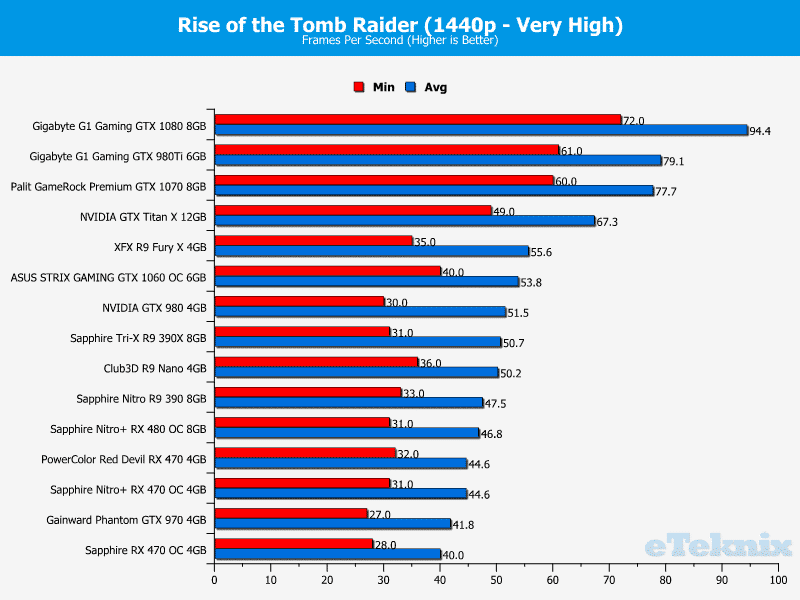
Unsurprisingly, the frame-rate is unplayable when using a 4K panel.
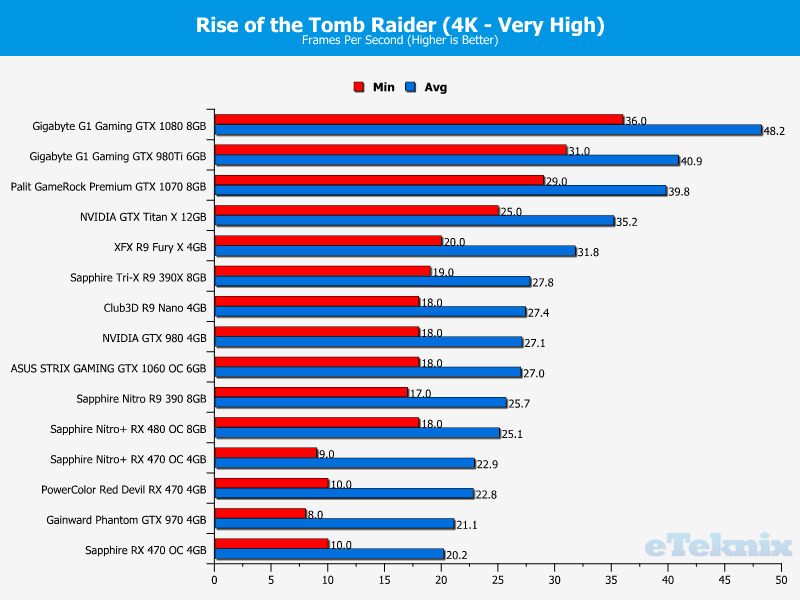
Overclocking and Overclocked Performance
The revised review procedure now involves analysing the factory boost clock to determine if the quoted speed is maintained on a regular basis. Thankfully, Sapphire’s 1260MHz boost is completely stable and never fluctuates from this figure resulting in consistent performance. This is the polar opposite of the Sapphire reference model which very rarely maintains its maximum boost clock.

Overclocking the graphics card was a simple task and I managed to increase the boost clock to 1350MHz without any issues. Initially, I tried to achieve a figure around 1370MHz with a substantial voltage increase but this just wasn’t possible. Speaking of voltages, please note the highest option in Wattman was applied and the overclock didn’t involve stock or lower voltages despite the screenshot below. On another note, the memory overclocked rather well and performed well at 1795MHz.
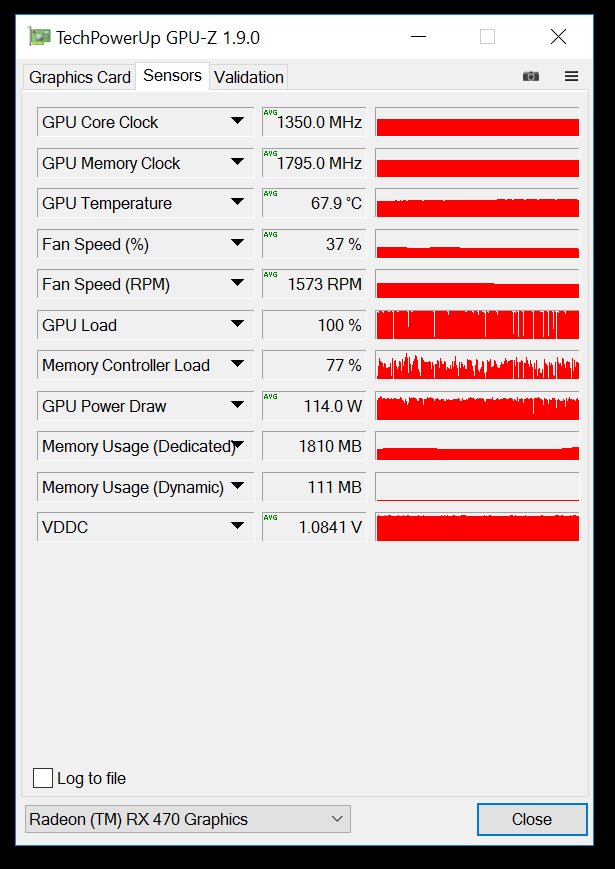
Here we can see the screenshot comparing the factory overclock and gains from manual overclocking:

Ashes of the Singularity
Once overclocked, the graphics card managed a small frame-rate improvement which is within a margin of error.
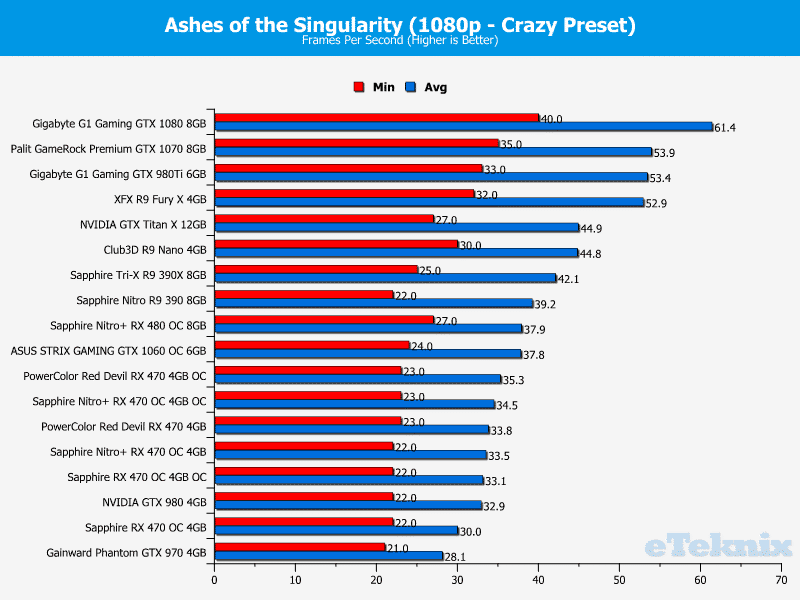
Doom
In Doom, the performance boost was more substantial and closed the gap to the RX 480.
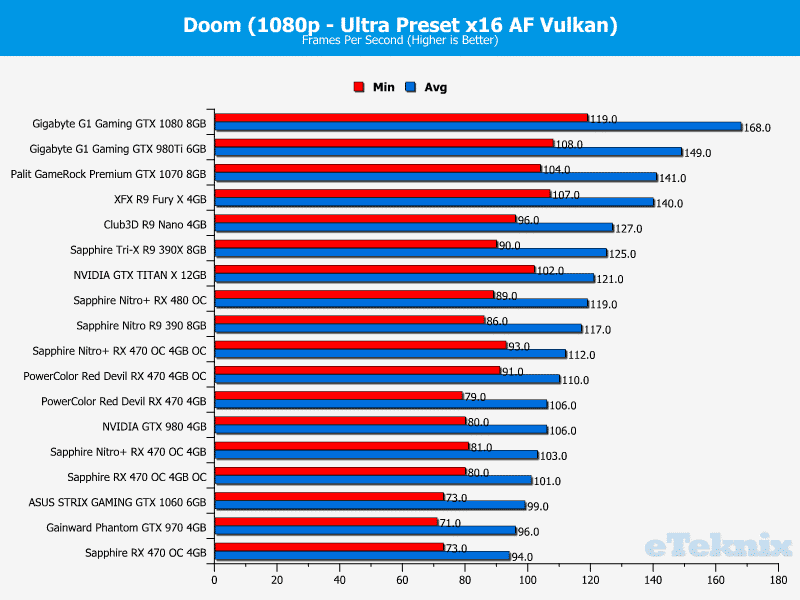
Just Cause 3
Rather impressively, the GPU achieved an identical average frame-rate as the RX 480 when overclocked and the minimum was slightly higher. Again, another strong showing and minor difference to the RX 480 after overclocking.
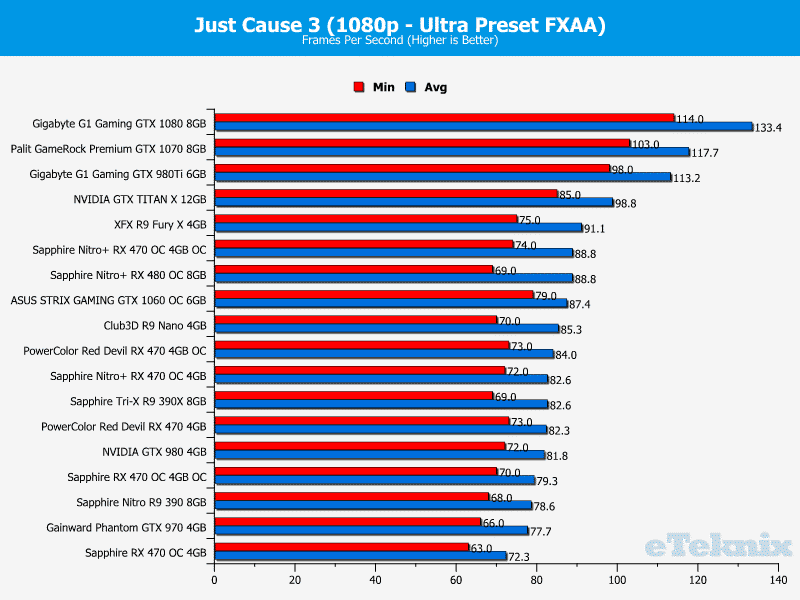
Noise, Power Consumption and Temperatures
Noise
Sapphire have incorporated a 0dB fan mode which only turns on the fans once the temperatures surpass 52C. As a result, the GPU is silent when browsing the web, streaming video and playing casual games. Under load, the noise output is quiet and a vast improvement on the Sapphire reference model.
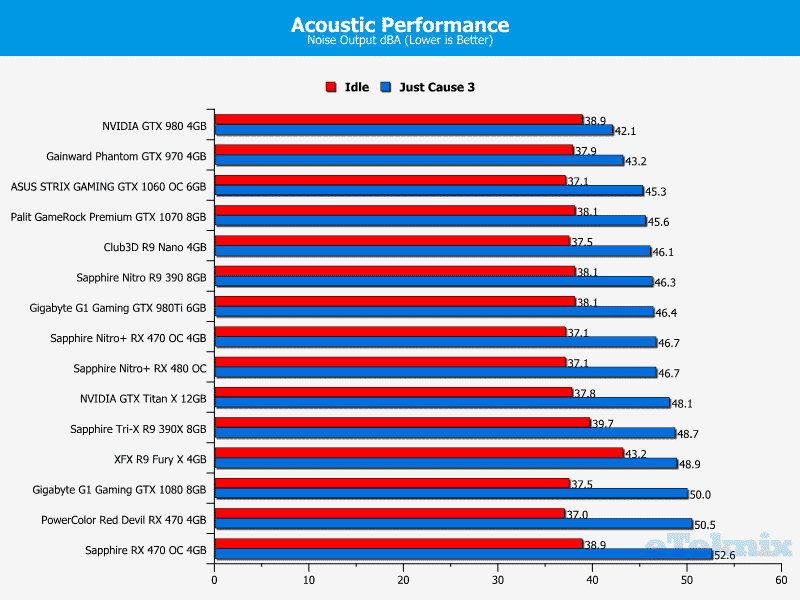
Power Consumption
As expected, the total system power consumption is pretty low given the X99 platform but it’s not as efficient as the GTX 1060 or the GTX 1070.
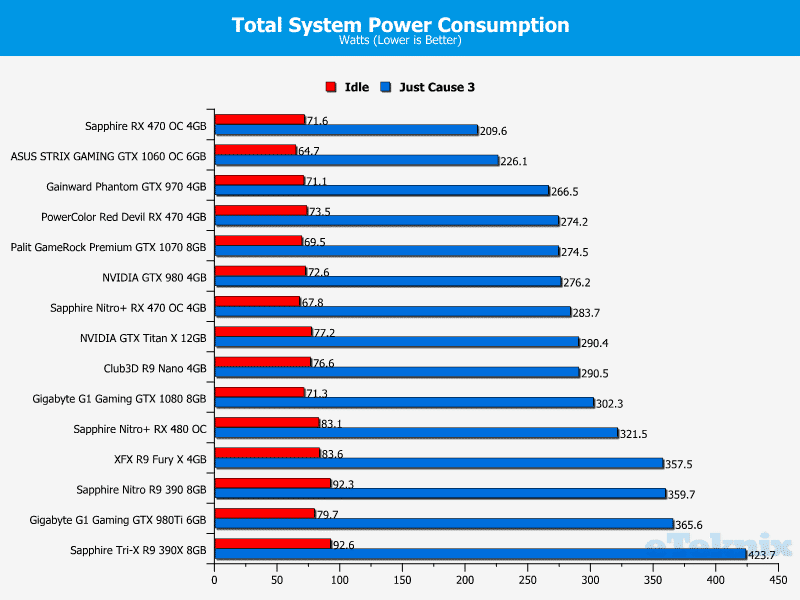
Temperatures
The Sapphire Nitro+ RX 470 is engineered to run at 75C but from my experience, the average temperature hovers around 71C. This is a superb result which showcases the cooling solution’s proficiency.
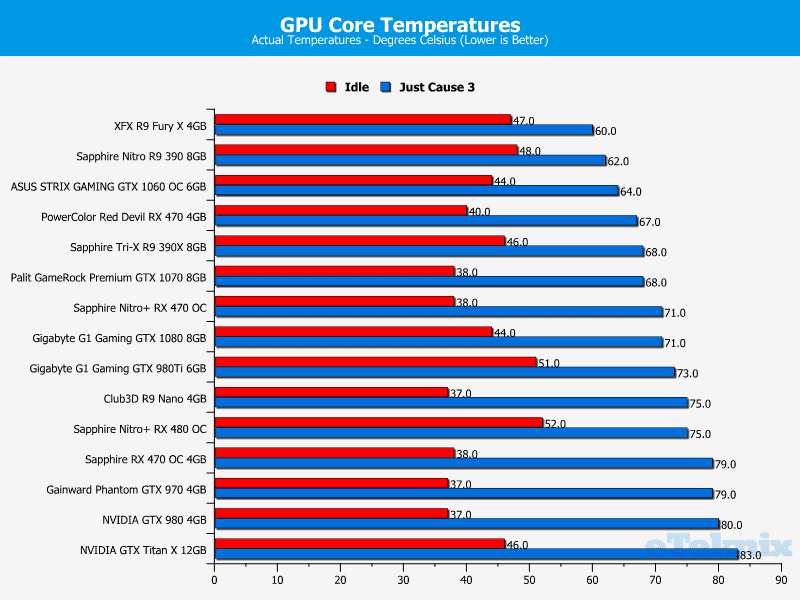
Final Thoughts
Price
Unfortunately, the pricing of AMD’s RX 470 hasn’t been divulged to reviewers in a swift and concise manner. Currently, the retail prices are subject to change and I’ve received some conflicting reports. Right up to the embargo being released, this section was edited to reflect new information. According to AMD, the Sapphire RX 470 OC will cost £164.99 in the UK from Overclockers UK. This isn’t a great exchange rate since US customers can acquire models starting from $179.99. Of course, the current devaluation of Sterling is probably the root cause of this and unavoidable. Custom models will rightfully cost more and I’ve been quoted a £189.99 price on the ASUS STRIX GAMING RX 470. This is perilously close to the RX 480 and I hope the pricing comes down after launch. For example, the Sapphire Nitro+ RX 480 OC 4GB is available to pre-order from Overclockers UK for £199.99 . This isn’t a basic reference model either and makes you question the RX 470’s price point.
In my opinion, the RX 470 reference model should cost no more than £154.99 to remain an enticing proposition. The small price gap to a highly-rated custom model will simply make consumers pay the extra even if the performance is similar. Furthermore, the reference model cannot uphold its maximum boost clock. Psychologically, owning the higher-end product creates a heightened sense of pride and users are more likely to display their systems with the RX 480. I’m not entirely sure how AIB partners can expect to market custom designs if they’re the same price or within £5-10 of the RX 480. Evidently, AMD hasn’t created a suitable price disparity between their two Polaris 10 chips and this is probably going to result in weak sales.
Overview
Aesthetically-speaking, the Sapphire Nitro+ RX 470 OC is sublime and a work of art. The understated theme revolves around a stylish black cooling shroud which compliments a wide range of components with different colour schemes. Not only that, the tiny holes scattered around the cooling shroud is an ingenious idea with simplicity at its heart. This gives the product a signature appearance without detracting from a sleek, subtle design. On another note, the silver backplate is stunning and leaves a lasting impression. As previously mentioned, it’s probably the most attractive backplate I’ve encountered and oozes such a premium feel. This is impressive because the GPU is targeted towards mainstream users. I’m also quite fond of Sapphire’s RGB implementation which has enough exuberance to please users who enjoy viewing the full colour spectrum. Amazingly, it’s included in a way which doesn’t distract you or come across as overly gimmicky. Evidently, the company’s aim was to unleash a mass market GPU which doesn’t make any concessions in the build quality department.
When it comes to cooling, the graphics card does remarkably well and greatly benefits from the large heatsink sporting a dense fin array and multiple heat-pipes. Additionally, the high-angled fan blades offer superb airflow and enhance thermal dissipation. Another great feature is the ability to uncouple the fans for cleaning purposes or to raise a swift RMA. The 0dB fan profile is fantastic for users who value silence and often use their PCs for non-gaming tasks like movie playback. Throughout the testing, the thermal output remained very low and the noise levels were much quieter than Sapphire’s RX 470 reference design. Thankfully, the fan bug which plagued the RX 480 model appears to have been fixed in AMD’s latest driver.
The Sapphire Nitro+ RX 470 OC’s performance is commendable and consistently outperforms the reference design by a large degree. Also, it’s able to compete with another premium RX 470 card due to the extreme 1260MHz boost clock. Unlike the reference unit, the boost clock is perfectly stable and doesn’t fluctuate. Throughout the testing, it was clear that the GPU has enough horsepower to tame games like Far Cry Primal, Rise of the Tomb Raider and Hitman while using demanding presets. In some circumstances, it’s even suitable for 1440p gaming while running advanced details. Overall, the graphics card is very similar to the RX 480 but there are some instances when this pattern doesn’t apply. For example, the RX 480 enjoys a significant lead in Hitman. Perhaps, the additional VRAM comes into play or there’s just some variation causing this in the benchmarking runs. Whatever the case, I was surprised to see how close the RX 470 is to custom RX 480s. Please note, I originally intended to include the reference RX 480 but this wasn’t possible as AMD required the sample back.
In terms of overclocking, the graphics card has lots of headroom and I manage to reach 1350MHz quite easily. This is higher than the PowerColor model but in all honesty, there’s not a lot of difference between these two editions. Nevertheless, you should be able to get at least 1330MHz, and perhaps 1370MHz on lucky samples. Sapphire’s overclocking utility which is going to be released soon could unlock the core’s full potential. However, this is speculation and requires further testing to verify.
Pros
- 0dB fan mode
- Dual BIOS
- Exceptional build quality
- Fast 1260MHz factory overclock
- Gorgeous backplate
- Great performance
- Low Temperatures
- Remarkably quiet
- Sophisticated design
- Superb overclocking headroom
Cons
- Priced too close to the RX 480 (Could change)
“The Sapphire Nitro+ RX 470 OC has an impressive 1260MHz boost clock which provides a wonderful performance boost over the reference model. Also, the stunning design exudes a premium feel and adds an elegant touch to any system build.”

Sapphire Nitro+ RX 470 OC 4GB Graphics Card Review
Thank you Sapphire for providing us with this review sample.



















